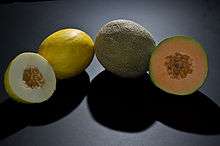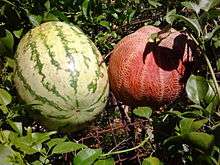Melon


A melon is any of various plants of the family Cucurbitaceae with sweet edible, fleshy fruit. The word "melon" can refer to either the plant or specifically to the fruit. Botanically, a melon is a kind of berry, specifically a "pepo". The word melon derives from Latin melopepo,[1] which is the latinization of the Greek μηλοπέπων (mēlopepon), meaning "melon",[2] itself a compound of μῆλον (mēlon), "apple"[3] and πέπων (pepōn), amongst others "a kind of gourd or melon".[4] Many different cultivars have been produced, particularly of muskmelons.
History

Melons originated in Africa[5] and southwest Asia,[6] but they gradually began to appear in Europe toward the end of the Roman Empire. However recent discoveries of melon seeds dated between 1350 and 1120 BC in Nuragic sacred wells have shown that melons were first brought to Europe by the Nuragic civilization of Sardinia during the Bronze Age.[7] Melons were among the earliest plants to be domesticated in both the Old and New Worlds.[8] Early European settlers in the New World are recorded as growing honeydew and casaba melons as early as the 1600s.[6] A number of Native American tribes in New Mexico, including Acoma, Cochiti, Isleta, Navajo, Santo Domingo and San Felipe, maintain a tradition of growing their own characteristic melon cultivars, derived from melons originally introduced by the Spanish. Organizations like Native Seeds/SEARCH have made an effort to collect and preserve these and other heritage seeds.[9]
Melons by genus

Benincasa
- Winter melon[note 1] (B. hispida) is the only member of the genus Benincasa. The mature winter melon is a cooking vegetable that is widely used in Asia and India. The immature melons are used as a culinary fruit (e.g., to make a distinctive fruit drink).
Citrullus
- Egusi (C. lanatus) is a wild melon, similar in appearance to the watermelon. The flesh is inedible, but the seeds are a valuable food source in Africa.[10] Other species that have the same culinary role, and that are also called egusi include Cucumeropsis mannii and Lagenaria siceraria.[11]
- Watermelon (C. lanatus) originated in Africa, where evidence indicates that it has been cultivated for over 4,000 years.[12] It is a popular summer fruit in all parts of the world.[13]
Cucumis
Melons in genus Cucumis are culinary fruits, and include the majority of culinary melons. All but a handful of culinary melon varieties belong to the species Cucumis melo L.
- Horned melon (C. metuliferus), a traditional food plant in Africa with distinctive spikes. Now grown in California, Chile, Australia and New Zealand as well.[14]
- Muskmelon (C. melo)
- C. melo cantalupensis, with skin that is rough and warty, not netted.Slice of Cantaloupe melon
- The European cantaloupe, with lightly ribbed, pale green skin, was domesticated in the 18th century, in Cantalupo in Sabina, Italy, by the pope's gardener. Varieties include the French Charentais and the Burpee Seeds hybrid Netted Gem, introduced in the 19th century.[15] The Yubari King is a highly prized Japanese cantaloupe cultivar.
- The Persian melon resemble a large cantaloupe with a darker green rind and a finer netting.[16]
- C. melo inodorus, casabas, honeydew, and Asian melons
- Argos, a large, oblong, with orange wrinkled skin, orange flesh, strong aroma. A characteristic is its pointed ends. Growing in some areas of Greece, from which it was named.
- Canary melon, a large, bright-yellow melon with a pale green to white inner flesh.
- Casaba, bright yellow, with a smooth, furrowed skin. Less flavorful than other melons, but keeps longer.[17]
- Hami melon, originally from Hami, Xinjiang, China. Flesh is sweet and crisp.[18]
- Honeydew, with a sweet, juicy, green-colored flesh. Grown as bailan melon in Lanzhou, China. There is a second variety which has yellow skin, white flesh and tastes like a moist pear.
- Kolkhoznitsa melon, with smooth, yellow skin and dense, white flesh.[19]
- Japanese melons (including the Sprite melon).
- Korean melon, a yellow melon with white lines running across the fruit and white inside. Can be crisp and slightly sweet or juicy when left to ripen longer.
- Piel de Sapo (toad skin) or Santa Claus melon, with a blotchy green skin and white sweet-tasting flesh.
- Sugar melon a smooth, white, round fruit.[20]
- Tiger melon, an orange, yellow and black striped melon from Turkey with a soft pulp.[21]
- C. melo reticulatus, true muskmelons, with netted (reticulated) skin.
- North American cantaloupe, distinct from the European cantaloupe, with the net-like skin pattern common to other C. melo reticulatus varieties.[22]
- Galia (or Ogen), small and very juicy with either faint green or rosy pink flesh.[16]
- Sharlyn melons, with taste between honeydew and cantaloupes, netted skin, greenish-orange rind, and white flesh.[23]
- Modern crossbred varieties, e.g. Crenshaw (Casaba × Persian), Crane (Japanese × N.A. cantaloupe).
- C. melo cantalupensis, with skin that is rough and warty, not netted.
See also
- Cucurbita - Squash (plant)
- List of culinary fruits
- List of gourds and squashes
- List of melon dishes
Notes
- ↑ Not to be confused with Cucumis melo inodorus varieties, also collectively called winter melon.
References
- ↑ Charlton T. Lewis; Charles Short (1879). "melopepo". A Latin Dictionary. Oxford University Press.
- ↑ Henry George Liddell; Robert Scott (1925). "μηλοπέπων,". A Greek-English Lexicon (ninth ed.). Oxford University Press.
- ↑ Liddell et al, "μῆλον"
- ↑ Liddell et al, "πέπων"
- ↑ John Griffith Vaughan; Catherine Geissler (2009). The New Oxford Book of Food Plants (second ed.). Oxford University Press. p. 134. ISBN 0-19-954946-X.
- 1 2 "Growing Melons". University of Nebraska-Lincoln Extension. Retrieved 2011-11-04.
- ↑ Archaeobotanical analysis of a Bronze Age well from Sardinia: A wealth of knowledge
- ↑ Dhillon, Narinder P.S.; Monforte, Antonio J.; Pitrat, Michel; Pandey, Sudhakar; Singh, Praveen Kumar; Reitsma, Kathleen R.; Garcia-Mas, Jordi; Sharma, Abhishek; McCreight, James D. (2012). Jules Janick, ed. "Melon Landraces of India: Contributions and Importance". Plant Breeding Review. John Wiley & Sons. 35: 88. ISBN 1118100484. Retrieved 2014-10-20.
- ↑ Denise Miller (September 24, 2008). "San Felipe Pueblo melon farmer favors the old ways". Albuquerque Journal. Retrieved 2014-10-20.
- ↑ Danielle Nierenberg. "Seeds, seeds, seeds: Egusi, the Miracle Melon". Nourishing the Planet.
- ↑ Enoch Gbenato Achigan-Dako; Rose Fagbemissi; Hermane Tonankpon Avohou; Raymond Sognon Vodouhe; Ousmane Coulibaly; Adam Ahanchede (2008). "Importance and practices of Egusi crops (Citrullus lanatus (Thunb.) Matsum. & Nakai, Cucumeropsis mannii Naudin and Lagenaria siceraria (Molina) Standl. cv. ' Aklamkpa ') in sociolinguistic areas in Benin" (PDF). Biotechnol. Agron. Soc. Environ. 12 (4): 393–40. Retrieved 2014-10-20.
- ↑ Daniel Zohary & Maria Hopf (2000). Domestication of Plants in the Old World (3 ed.). Oxford University Press. p. 193.
- ↑ "Citrullus lanatus (Thunb.) Matsum. & Nakai". Grassland Species Profiles. FAO.
- ↑ G.N. Njorogo; M.N. van Luijk (2004). "Momordica". In G.J.H. Grubben; O.H. Denton. Plant Resources of Tropical Africa: Vegetables. Wageningen, Netherlands: PROTA Foundation. p. 248. ISBN 90-5782-147-8. Retrieved 2014-10-20.
- ↑ Anthony F. Chiffolo; Rayner W. Hesse (2006). Cooking with the Bible: biblical food, feasts, and lore. Greenwood Publishing Group. p. 255. ISBN 0-313-33410-2. Retrieved 2014-10-20.
- 1 2 Heidemarie Vos (2010). Passion of a Foodie - An International Kitchen Companion. Strategic Book Publishing. p. 348. ISBN 1-934925-63-2. Retrieved 2014-10-20.
- ↑ "What is a casaba melon?". WiseGeek. Retrieved 2014-10-20.
- ↑ "Xinjiang Hami Melon". Library>China ABC>Geography>Local Products. China Daily. Retrieved 2014-10-20.
- ↑ "Moscow flooded with melons". The Moscow Times. September 21, 2007. Retrieved 2014-10-20.
- ↑ Jac G. Constant (1986). The Complete Book of Fruit: an illustrated guide to over 400 species and varieties of fruit from all over the world. Admiral. p. 35. ISBN 1-85171-049-3.
- ↑ Judy Bastyra, Julia Canning (1990). A Gourmet's Guide to Fruit. HP Books. p. 64. ISBN 0-89586-849-0.
- ↑ Linda Ziedrich (2010). The Joy of Jams, Jellies and Other Sweet Preserves: 200 Classic and Contemporary Recipes Showcasing the Fabulous Flavors of Fresh Fruits (Easyread Large Edition). ReadHowYouWant.com. p. 116. ISBN 1-4587-6483-4. Retrieved 2014-10-20.
- ↑ James Ehler. "Melons". Food Reference. Retrieved 2014-10-20.
General references
- Mabberley, D.J. (1987). The Plant Book. A portable dictionary of the higher plants. Cambridge University Press. p. 706. ISBN 0-521-34060-8. Retrieved 2014-10-20.
- Magness, J.R., G.M. Markle, C.C. Compton (1971). "Food and feed crops of the United States". IR Bulletin. New Jersey Agricultural Experiment Station. 1 (828). OL 14117370M. Interregional Research Project IR-4
External links
| Wikimedia Commons has media related to Melons. |
- "Cucumis melo L.". Purdue University, Center for New Crops & Plant Products. Retrieved 2014-10-20.
- "Sorting Cucumis names". Multilingual multiscript plant name database. Retrieved 2014-10-20.